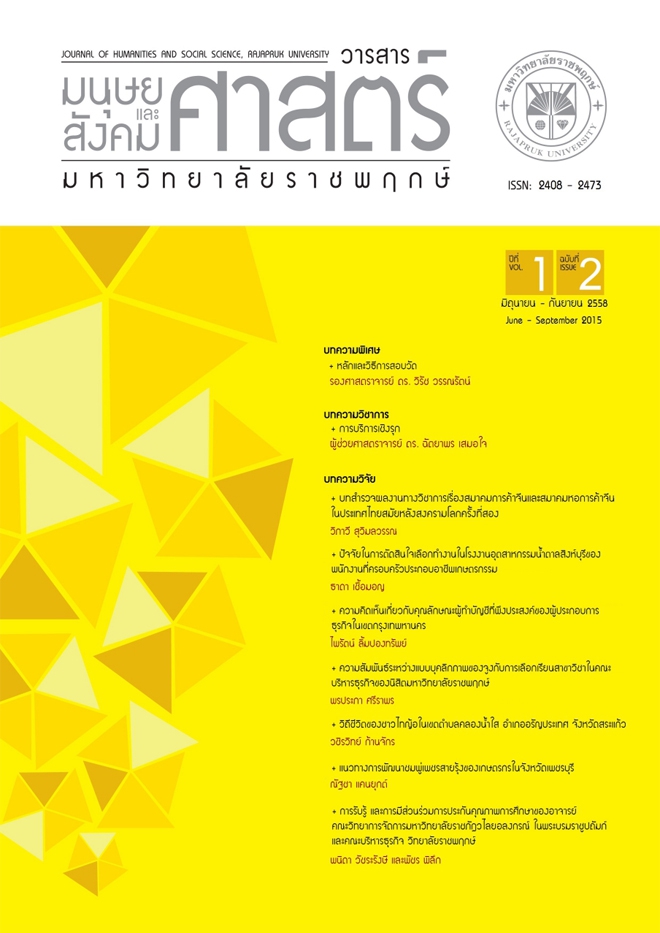The Decision Factors to work at Singburi Sugar Industry of Employees Whose Family has Agriculture Occupy
Main Article Content
Abstract
The objectives of this research were 1) to study the decision factors to working at Singburi sugar industry of employees whose family has agricultural occupy. 2) to compare the decision factors to working at Singburi sugar industry of employees whose family has agricultural occupy with personal factors. The samples sizes of this research were 219 members of Singburi sugar industrial of employees, and 10 farmers to in depth interview. Data were collected by questionnaire and analyzed by using SPSS. Statistics used for data analysis were percentage, mean, standard deviation, t-test, F-test, and Scheffe’ test statistically significant was set at .05 levels.
The result of this research the Decision Factors to Working at Singburi sugar industry founded that: Push factors consisted economic factors was high level and social factors was moderate level while, pull factors was moderate level in economic and social. The Hypothesis testing found that the employees’ personal factors in terms of age, education level, members of family, land ownership, hometown which were all different in terms of decision factors with statistical significance at .05 level. Therefore, personal factors included sex, marital status and the persuade person were not different in factors decision.
Article Details
References
เกินศักดิ์ ศรีสวย. (2552). การศึกษาสภาพและแนวทางในการส่งเสริมการสืบทอดอาชีพทำนาของ ลูกชาวนา. วิทยานิพนธ์ครุศาสตรมหาบัณฑิต สาขาวิชาพัฒนศึกษา, จุฬาลงกรณ์ มหาวิทยาลัย.
จีรนันท์ ไวยศรีแสง. (2552). ปัจจัยที่มีผลต่อการตัดสินใจเลือกประกอบอาชีพของนักศึกษาระดับ ปริญญาตรีในสถาบันอุดมศึกษาของรัฐและเอกชน ในเขตกรุงเทพมหานคร. วิทยานิพนธ์ ศิลปศาสตรมหาบัณฑิต สาขาบริหารการพัฒนาสังคม สถาบันบัณฑิตพัฒนบริหารศาสตร์.
ชวพฤฒ อิทรเทศ. (2551). คนรุ่นใหม่เผ่นหนีทำงานภาคเกษตร เหตุงานหนักรายได้น้อย แนะรัฐ เร่งเพิ่มสวัสดิการยั่วใจ. ค้นเมื่อ 29 ตุลาคม 2556, http://www.naewna.com/news. asp?ID=130529
บุญชม ศรีสะอาด. (2554). การวิจัยเบื้องต้น. พิมพ์ครั้งที่ 9. กรุงเทพฯ: สุรีวิทยาสาส์น.
บุญเรียง ขจรศิลป์. (2533). สถิติวิจัย. กรุงเทพฯ: ฟิสิกส์เซ็นเตอร์.
แผนกทรัพยากรบุคคล บริษัทน้ำตาลสิงห์บุรีจ้ากัด. (2557). แบบรายงานบุคคลากร.
สำนักงานสถิติแห่งชาติ. (2555). ทิศทางการทำงานของแรงงานไทย. ค้นเมื่อ 15 มีนาคม 2557, http://service.nso.go.th/nso/nsoublish/citizen/news/news_lfsdirect.jsp
สุภชัย ปิติวุฒิ. (2557). ระบบผลิต เปียกสลับแห้ง แกล้งข้าว. ค้นเมื่อ เข้าถึง 9 ธันวาคม 2557, http://www.oae.go.th/download/bapp/2557/supachai1.pdf.
สุรินทร์ พงศ์ศุภสมิทธิ์. (2553). เทคโนโลยีแบบพอเพียง: การพัฒนาเครื่องจักรกลการเกษตรเพื่อชุมชน. ค้นเมื่อ 13 มกราคม 2558, www.csr.chula.ac.th/sufficiency_economy/images/.../article_surin.pdf.
อรรณพ คุณาวงษ์กฤต. (2556). เกษตรพอเพียงหรือเกษตรอุตสาหกรรม. ค้นเมื่อ 15 มีนาคม 2556, www.cusar.chula.ac.th/index.php/article/15-2013-03-11-08-57-53
อัจฉรีย์ จันทลักขณา. (2544). หลักสถิติเพื่อการวิเคราะห์ข้อมูลทั่วไป. พิมพ์ครั้งที่ 3. กรุงเทพฯ: บัณฑิตวิทยาลัย มหาวิทยาลัยเกษตรศาสตร์.


